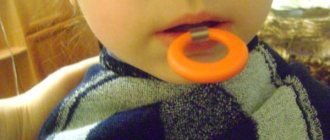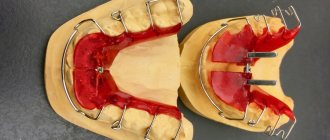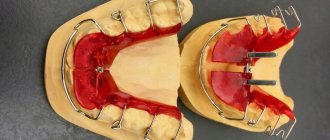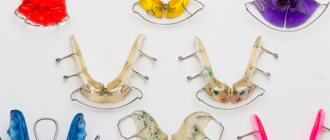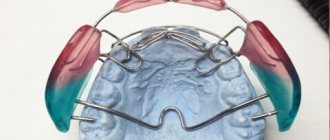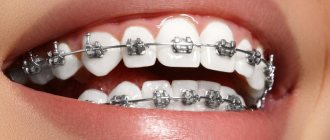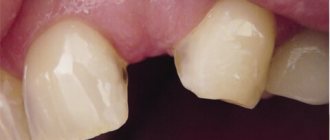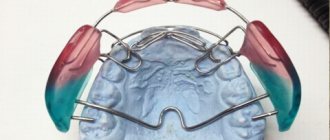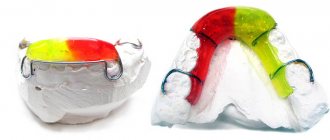Technologies that make it possible to correct defects in the development of the jaw row and bite provide high effectiveness when organizing competent treatment. One popular mechanism is orthodontic plates, which allow you to focus pressure on individual teeth. Under the influence of load they shift and take the correct position. The Katz bite block is an effective way to restore the dentition and normalize the bite.
Description and characteristics
The model in question is a plastic product attached to the palate of the mouth. The work is based on the principle of pressure that occurs during the work of the masticatory muscles. The functionality that the bite block implements occurs only when the jaws close. The intensity of muscle work determines better the final result. Muscular traction that occurs due to unusual forced positioning of the jaw also affects the movement of dental units.
The bite block is attached to the upper jaw using clasps. The part of the device in contact with the frontal incisors is formed in an inclined form, at an angle of 45°, ensuring constant sliding of the teeth, due to which gradual advancement and adaptation occurs. At the same time, it does not adhere to the front part of the palate, so the teeth themselves become the main point of support.
Katz bite block
This is a removable plate for the upper jaw with flip-over clasps for its incisors. The device is strengthened using reversible clasps on the second premolars or first molars. In the anterior part of the palate, the plate does not adhere to the mucous membrane and necks of the teeth.
The Katz bite block is used in the treatment of prognathic dentition with deep incisal overlap. The effect of this device, like all bite plates with an inclined plane, is that the lower front teeth, in contact with the inclined plane, are deflected towards the lip and are partially immersed in the alveolus.
It should be borne in mind that this involves a restructuring of the bone tissue of the alveolar process, and not just the introduction or movement of teeth. In the area of the lateral teeth, which are separated, dentoalveolar elongation occurs, i.e.
Katz bite block
protrusion of teeth from the alveoli and construction of bone tissue in the vertical direction. With such a restructuring, i.e., the introduction of anterior and dentoalveolar advancement of the lateral teeth, the depth of the incisal overlap decreases. At the same time, the lower jaw moves forward and is held in this position by an inclined plane.
Prolonged protraction of the lower jaw leads to adaptive restructuring of the temporomandibular joint, jaw bones and musculo-ligamentous apparatus. As a result of this, the relationships of the jaws and dentition in the anteroposterior direction are normalized. Thus, when using plates with a guide inclined plane, a restructuring of the entire dental system occurs, leading to the elimination of the prognathic relationship of the dentition and deep bite.
The group of removable functional-guiding devices includes a plate for the upper jaw with an inclined plane and a vestibular wire arch, which is used in the treatment of prognathic relationship of the dentition with deep incisal overlap, as well as a plastic mouth guard with an inclined plane by B. N. Bynin, which is used in the treatment progeny in children.
Kappa Bynina
It covers all the teeth of the lower jaw, reaching the necks. In the area of the incisors and canines there is an inclined plane. When the dentitions close, the front teeth of the upper jaw, in contact with the inclined plane, slide along it towards the lip and are partially immersed in the alveolus. Therefore, this device is used to treat palatal inclination of the maxillary incisors, progenic relationship of the anterior teeth and false progeny with deep reverse overlap of the incisors.
When using Bynin's mouth guard in the area of separated upper lateral teeth, dentoalveolar elongation is observed, i.e., premolars and molars, together with the alveolar process, descend downwards. As a result of this, after some time the lateral teeth come into contact with the chewing surface of the mouthguard and the action of the device stops. To continue treatment, the chewing surface of the mouthguard is ground off, and thereby the bite in the lateral areas is again separated.
The force of contraction of the masticatory muscles is again transmitted to the anterior teeth of the upper jaw, which come into contact with the inclined plane and move to the labial side. When treating forced progeny with this device, along with the movement of the upper front teeth forward, there is also a slight displacement of the entire lower jaw distally, i.e., to the normal position.
“Childhood Dentistry”, A.A. Kolesov
Combined action devices
Combined action devices contain elements of mechanical and functional devices. Their design must include an inclined plane or bite pad in combination with mechanical devices (screw, spring, rubber rod, etc.). Combined action devices include: Gulyaeva apparatus; Khurgina apparatus; Bruckle's apparatus; activators of Andresen and Goipl, etc.; functional Frenkel regulators. Gulyaeva’s apparatus is used…
Apparatus of Khurgina, Bruckle, Andresen and Goipl
Khurgina apparatus The Khurgina apparatus consists of a Katz bite plate and an expanding screw, which is located in the middle of the plate. It is used to treat prognathic dentition in combination with deep bite and narrowing of the upper dentition. Bruckle's apparatus The Bruckle's apparatus is a removable plate on the lower jaw with a vestibular wire arch. In the anterior section there is an inclined…
Activator
The activator is a removable plate device that covers the mucous membrane of the hard palate, the oral surface of all teeth of the upper and lower jaws, as well as the mucous membrane of the alveolar processes on the inside. The bed for each tooth forms an inclined plane along which it can be moved forward, backward or to the side. The teeth do not come into contact with the plate with their entire internal...
Functional Frenkel regulator
The functional Frenkel regulator consists of lateral and vestibular pellets located in the vestibule of the oral cavity in the area of the lateral and anterior teeth. They relieve the dentition from the pressure of the cheeks and lips and create conditions for normal jaw growth in the transversal and sagittal directions. In addition to these pilots, the device contains elements of mechanical devices in the form of a spring for moving teeth....
Structural changes in the dental system during orthodontic treatment
Orthodontic treatment of dentofacial deformities is based on changing the mechanical and functional load on various parts of the dentofacial system. It is achieved with the help of myogymnastic exercises or the use of orthodontic appliances. Under the influence of a changed load, tissue restructuring occurs, as a result of which it becomes possible to correct the deformity. The latter involves the movement of the teeth and lower jaw in different directions, as well as the expansion of the dental...
Purpose
At the preliminary stage, the patient undergoes a mandatory diagnostic examination, the results of which allow us to draw a conclusion about the feasibility of using the design. The priority is to correct the palatal position of abnormally growing units. The optimal age for the procedure is the period of 6-11 years, characterized by the formation of the final bite and the replacement of temporary elements of the dentition with permanent ones. If the technical conditions are met, the system allows you to align the entire jaw - for this it is necessary to maintain it in a certain position, which contributes to the development of sufficient muscle tension.
When treating adolescents, the adjustment plate gives the desired result already at the initial stage. Removable soft plastic systems are excellent for slowing or increasing the growth of individual units, adjusting the shape and position of the lower and upper jaw, and narrowing or widening the palate. The technique is successfully used to prevent prognathia, acting in two directions at once: sagittal (mesial displacement) and vertical (shortening the anterior and lengthening the lateral elements).
Lightweight and convenient plates made of plastic can be equipped with a screw, allowing you to freely change the size of the device. It is worth noting that in the first days of wearing the system will cause inconvenience to the child, interfering with speech and causing discomfort from the presence of a foreign body in the mouth. Adaptation lasts several days, after which the patient gets used to the product and stops paying attention to it.
Katz plate with bite block
MANUFACTURE OF DEVICES FOR NORMALIZING THE RELATIONSHIP OF DENTAL RANKS AND RETENTION APPLIANCES To change the relationship of the dentition, devices are used that are fixed on one or simultaneously on two jaws.
The operation of the devices is based on the use of an inclined plane or an intermaxillary rubber traction. In this case, not only does the lower jaw move, but at the same time a restructuring is possible in both the upper and lower dentition.
Katz plate with bite block
The device is a removable plate for the upper jaw, which has a plastic inclined plane and hooking loops for the frontal group of teeth.
The device is made on models fixed in the occluder in the position of the lower jaw that the doctor wishes to obtain as a result of treatment (i.e., moved forward).
On the model of the upper jaw, in the anterior third of the arch, in the area from the necks of the front teeth to the line connecting the distal surfaces of the canines, a tin spacer is placed. It is necessary so that the base in the frontal area does not adhere to the mucous membrane, thereby facilitating the penetration of the upper teeth. A wax base of the plate is formed along the tin spacer and the rest of the palate. Then regular or reversible clasps are made for the first molars.
Hook loops are bent from sheet steel 1.5-2 mm wide and 0.5-0.7 mm thick. Each loop should tightly cover the lower third of the vestibular surface of the tooth and the cutting edge. On the palatal side, the loop follows the relief of the tooth up to the labial tubercle, and then moves away from it. The degree of separation is determined by the line of closure of the lower teeth with the upper ones. The ends of the loops are flattened for better retention in the plastic. The manufactured loops are slightly heated, fixed on the tooth, and the tail part is immersed in a wax plate. Having closed the occluder, check whether all loops have simultaneous contact with the lower teeth. If one of the loops closes but the others do not, then this loop is bent more tightly to the tooth.
An inclined plane is modeled from a softened wax roller 1.5-2 cm high in the area from canine to canine. The roller is glued at an angle to the wax plate, and while the wax has not yet hardened, the occluder is closed. Having opened the occluder, we begin the final modeling of the inclined plane. The inclination of the plane in relation to the occlusal surface of the dentition should not exceed 45 degrees. The remaining stages of work are carried out in the same way as in the manufacture of conventional removable dentures. After finishing the plate from the palatal surface, the tin spacer is removed and polished.
Ya. S. Khurgina introduced an expanding screw into the Katz bite plate with the aim of simultaneously expanding the narrowed upper jaw. The production of this device consists of two stages: the production of a wax reproduction of the Katz plate with all its elements, and then the insertion of an orthodontic screw into the wax. The screw is located exactly in the center of the record.
Advantages of the correction technique
Using a correction system has a number of advantages:
- quick and effective correction of minor defects and anomalies;
- the possibility of complete hygienic oral care;
- low cost and fast production time of the structure.
The popularity of the model is due to the fact that it is one of the few devices whose use can be prescribed at an early age. Installation of braces and mouth guards is recommended after completion of the process of bone tissue formation, that is, not earlier than 12-13 years.
